文章目录
一、NIO介绍
二、NIO原理
-
NIO有三大核心部分: 通道(Channel)、缓冲区(Buffer)和选择器(Selector)。Channel是对原I/O体系中流的模拟,可以通过Channel完成数据的读/写操作;Buffer则用于存储数据,它是NIO与普通I/O的主要区别之一;而Selector则用于监听多个Channel的状态,以实现多路复用。
-
在NIO的工作过程中,数据首先从Channel读取到Buffer中,或者从Buffer写入到Channel中。这个过程是异步的,因此不会阻塞线程。同时,Selector会不断地轮询注册的Channel,查看是否有已经就绪的I/O操作(例如读或写),如果有,就通知相应的线程进行处理。
-
Java NIO的非阻塞模式,是一个线程从某通道发送请求或者读取数据,但是它仅能得到目前可用的数据,如果目前没有数据可用时,就什么都不会获取,而不是保持线程阻塞,所以知道数据变的可以读取之前,该线程可以继续做其他的事情。非阻塞写也是如此,一个线程请求写入一些数据到某通道,但不需要等待它完全写入,这个线程同时可以去做别的事情。
-
通俗理解:NIO是可以做到用一个线程来处理多个操作的。假设有10000个请求过来,根据实际情况,可以分配50或100个线程来处理。不像之前的阻塞 IO那样,非得分配10000个线程。
-
HTT2.0使用了多路复用的技术,做到同一个链接并发处理多个请求,而且并发请求的数量比HTTP1.1大了好几个数量级。
总的来说,NIO通过非阻塞I/O操作和事件驱动机制,提高了系统的并发性能和响应速度,使得处理大量连接和I/O操作变得更加高效。因此,NIO已经被越来越多地应用到大型应用服务器中,成为解决高并发与大量连接、I/O处理问题的有效方式。
三、Buffer
1、Buffer原理介绍
Java NIO的Buffer类是一个用于特定基本数据类型的容器。它是一个对象,包含一些要写入或者要读出的数据。在NIO中,所有的数据都是用Buffer处理的。在数据读写之前,需要先放入Buffer,或者从Buffer中取出。Buffer对象中提供了一组方法,可以轻松的使用内存块,此外缓冲区对象那中内置了一些机制,能够追踪和记录缓冲区的状态变化情况。
以下是Java NIO Buffer的基本使用步骤:
- 分配Buffer:首先,你需要通过调用allocate()方法(对于ByteBuffer,CharBuffer,DoubleBuffer,FloatBuffer,IntBuffer,LongBuffer,ShortBuffer等)在JVM的堆中分配一个新的Buffer。例如,以下代码分配一个新的ByteBuffer:
ByteBuffer buffer = ByteBuffer.allocate(48);
- 写入数据到Buffer:调用Buffer类的put()方法将数据写入Buffer。例如:
buffer.put((byte) 10);
buffer.put((byte) 20);
- 切换Buffer的读写模式:在写数据到Buffer后,需要调用flip()方法将Buffer从写模式切换到读模式。调用flip()方法会将position设回0,并将limit设置成之前position的值。换句话说,limit现在表示的是之前写进Buffer的元素的个数。现在Buffer准备好从写模式切换到读模式:
buffer.flip();
- 从Buffer中读取数据:从Buffer中读取数据,你可以使用get()方法。读取数据直到hasRemaining()返回false。这表示已经到达Buffer的末尾:
while(buffer.hasRemaining()){
byte b = buffer.get();
// do something with b
}
- 清除Buffer:当读完Buffer中的数据后,需要清除它以便下次使用。有两种方式可以清除Buffer:调用clear()或compact()方法。clear()方法会清除整个Buffer。compact()方法只会清除已经读过的数据。任何未读的数据都被移到Buffer的起始处,新写入的数据将放到Buffer的未读数据后面。
buffer.clear(); // 清除整个Buffer
或者
buffer.compact(); // 只清除已读数据
注意,在使用Buffer时,要时刻注意Buffer的容量(capacity),位置(position)和限制(limit)。容量是Buffer能够容纳的数据元素的最大数量;位置是下一个要被读或写的元素的索引;限制是第一个不应该被读或写的元素的索引。这些值可以通过调用Buffer的相应方法来获取或设置。
以上就是Java NIO Buffer的基本使用方法。通过合理地使用Buffer,你可以有效地处理大量的数据读写操作,提高程序的性能。
2、Buffer实现类
-
在NIO中,Buffer是一个顶层父类,它是一个抽象类,类的层级关系下图:
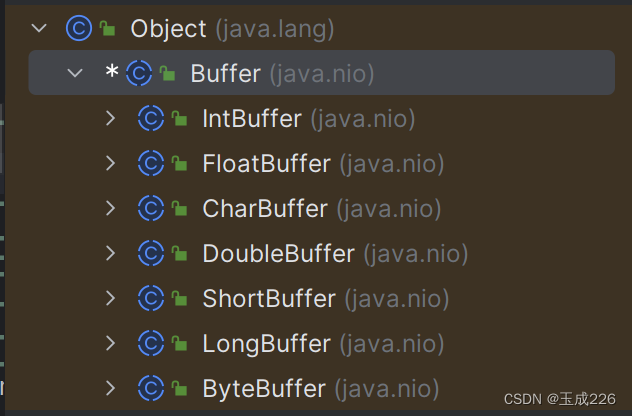
-
ByteBuffer:存储字节数据到缓冲区。
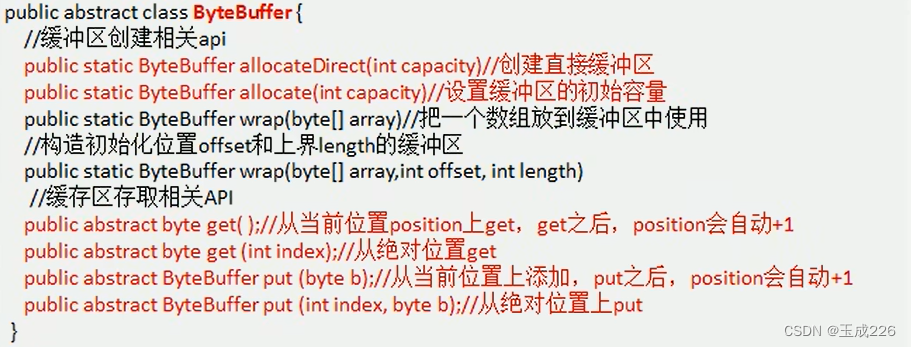
-
ShortBuffer:存储字符串数据到缓冲区。
-
CharBuffer:存储字符数据到缓冲区。
-
IntBuffer:存储整数数据到缓冲区。
-
LongBuffer:存储长整型数据到缓冲区。
-
DoubleBuffer:存储小数到缓冲区。
-
FloatBuffer:存储小数到缓冲区。
-
-
Buffer类定义了所有缓冲区都具有的四个属性,来提供其所包含的数据元素的信息:
| 属性 |描述 |
|–|–|
|capacity | 容量,即可以容纳的最大数据量;在缓冲区创建是被设定并且不能改变 |
|Limit| 表示缓冲区的当前终点,不能对缓冲区超过极限的位置进行操作。且极限是可以修改的|
|position| 位置,下一个要被读或写的元素的索引,每次读写缓冲区数据时都会改变,为下次读写做准备|
|mark| 标记| -
Buffer类相关的方法:
//JDK1.4,引入的api
public final int capacity(); //返回此缓冲区的容量
public final int position(); //返回此缓冲区的位置
public final Buffer position(int newPosition); //设置此缓冲区的位置
public final int limit(); //返回此缓冲区的限制
public final Buffer limit(int newLimit); //设置此缓冲区的限制
public final Buffer mark(); //在此缓冲区的位置设置标记
public final Buffer reset(); //将此缓冲区的位置重置为以前标记的位置
public final clear(); //清除此缓冲区,即将各个标记恢复到初始化状态,但是数据并没有真正擦除。
public final Buffer flip(); //反转此缓冲区
public final Buffer rewind(); //重绕此缓冲区
public final int remaining(); //返回当前位置与限制之间的元素数
public final boolean hasRemaining(); //告知当前位置和限制之间是否有元素
public final boolean isReadOnly(); //告知此缓冲区是否为只读缓冲区
//JDK1.6 引入的api
public abstract boolean hasArray(); //告知此缓冲区是否具有访问的底层实现数组
public abstract Object array(); //返回此缓冲区的底层实现数组
public abstract int arrayOffset(); //返回此缓冲区的底层实现数组中第一个缓冲区元素的偏移量
public abastract boolean isDirect(); //告知此缓冲区是否为直接缓冲区
3、示例
package test.nio;
import java.nio.IntBuffer;
public class BasicBuffer {
public static void main(String[] args) {
//创建一个buffer, 容量大小为5,即可以存放5个int
IntBuffer buffer = IntBuffer.allocate(5);
//向buffer中存放数据
for (int i = 0; i < buffer.capacity(); i++) {
buffer.put(i * 2);
}
//从buffer中读取数据
buffer.flip();
while(buffer.hasRemaining()) {
int i = buffer.get();
System.out.println(i);
}
}
}
运行结果:
0
2
4
6
8
Process finished with exit code 0
4、NIO和BIO的比较
- BIO以流的方式处理数据,而NIO以块的方式处理数据,块I/O的效率比流I/O高很多。
- BIO是阻塞的,NIO则是非阻塞的。
- BIO基于字节流和字符流进行操作,而NIO基于Channel(通道)和Buffer(缓冲区)进行操作,数据总是从通道读取到缓冲区中,或者从缓存区写入到通道中。Selector(选择器)用于监听多个通道的事件(比如:连接请求,数据到达等),因此使用单个线程就可以监听多个客户端通道。
四、Channel
1、介绍
-
Channel提供从文件、网络读取数据的渠道,但是读取或写入的数据都必须经由Buffer。

-
NIO的通道类似于流,有如下区别:
- 通道可以同时进行读写,而流只能读或者只能写。
- 通道可以实现异步读写数据。
- 通道可以从缓冲读数据,也可以写数据到缓冲:

- BIO中的stream是单向的,例如FileInputStream对象只能进行读取数据的操作。
-
BIO中的stream是单向的,例如FileInputStream对象只能进行读取数据的操作,而NIO中的通道(Channel)是双向的,可以读操作,也可以写操作。
-
Channel在NIO中是一个接口
public interface Channel extends Closeable
- 常用的Channel类有:FileChannel、DatagramChannel、ServerSocketChannel和SocketChannel(ServerSocketChannel类似ServerSocket、SocketChannel类似Socket)。
- FileChannel用于文件的数据读写,DatagramChannel用于UDP的数据读写,ServerSocketChannel
2、FileChannel介绍
-
FileChannel主要用来对本地文件进行IO操作,常见的方法有:
- public int read(ByteBuffer dst),从通道读取数据并放到缓冲区中。
- public int write(ByteBuffer src),把缓冲区的数据写到通道中。
- public long transferForm(ReadableByteChannel src, long position, long count),从目标通道中复制数据到当前通道。
- public long transferTo(long position, long count, WritableByteChannel target),把数据从当前通道复制给目标通道。
-
通过channel向文件中写数据。
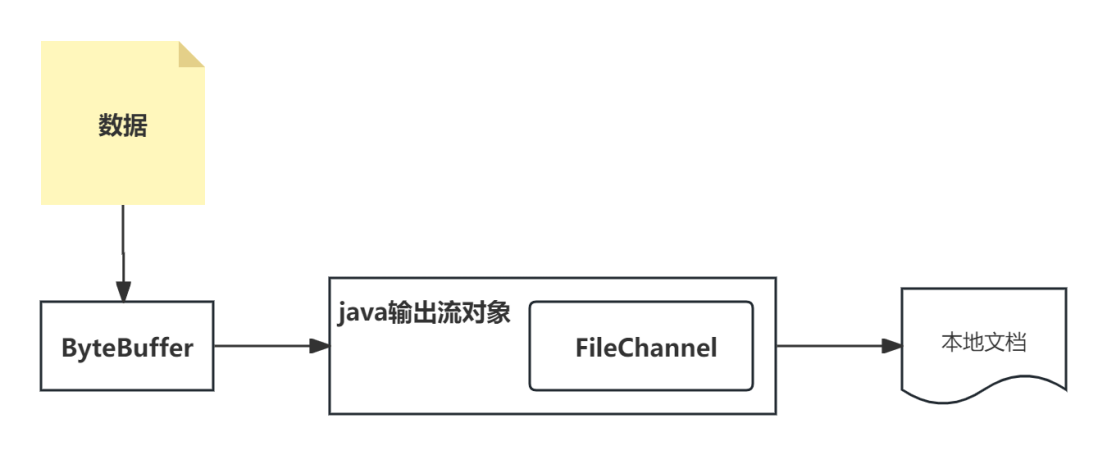
package test.nio;
import java.io.FileOutputStream;
import java.nio.ByteBuffer;
import java.nio.channels.FileChannel;
public class NIOFileChannel {
public static void main(String[] args) {
String str = "hello world 今天是星期日";
try {
//创建一个输出流->channel
FileOutputStream fileOutputStream = new FileOutputStream("d:\\file01.txt");
//通过fileOutputStream获取对应的FileChannel
//这个fileChannel真实类型是FileChannelImpl
FileChannel channel = fileOutputStream.getChannel();
//创建一个缓冲区ByteBuffer
ByteBuffer byteBuffer = ByteBuffer.allocate(1024);
//将str放入byteBuffer
byteBuffer.put(str.getBytes());
//对byteBuffer进行flip
byteBuffer.flip();
//将byteBuffer,数据写入到fileChannel
channel.write(byteBuffer);
fileOutputStream.close();
} catch (Exception e) {
throw new RuntimeException(e);
}
}
}
- 通过Channel读取本地文件数据。
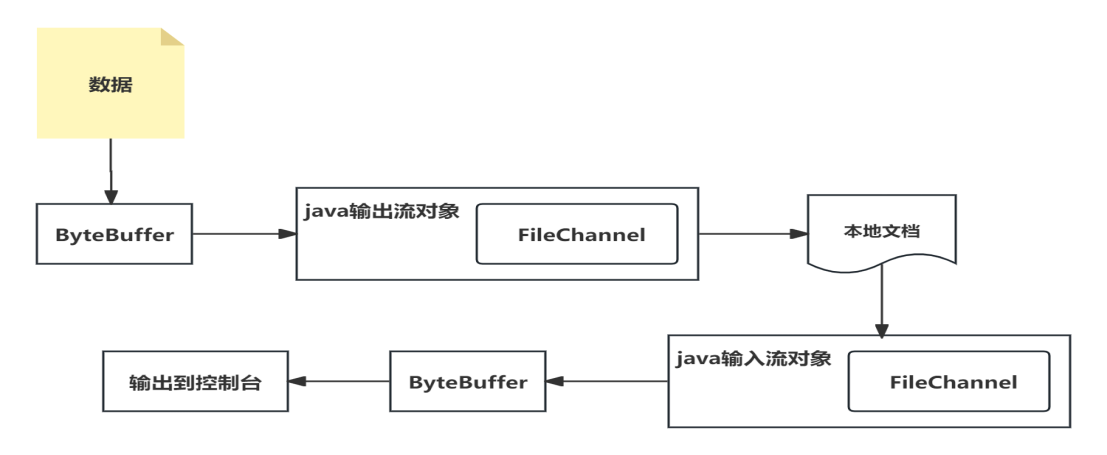
package test.nio;
import java.io.File;
import java.io.FileInputStream;
import java.io.IOException;
import java.nio.ByteBuffer;
import java.nio.channels.FileChannel;
public class NIOFileChannel01 {
public static void main(String[] args) throws IOException {
File file = new File("d:\\file01.txt");
FileInputStream fileInputStream = new FileInputStream(file);
FileChannel channel = fileInputStream.getChannel();
//创建一个缓冲区ByteBuffer
ByteBuffer byteBuffer = ByteBuffer.allocate((int)file.length());
//将通道的数据读入到Buffer
int read = channel.read(byteBuffer);
//将byteBuffer的字节数据转成String
byteBuffer.flip();
String str = new String(byteBuffer.array());
System.out.println(str);
fileInputStream.close();
}
}
结果展示:
hello world 今天是星期日
Process finished with exit code 0
- 使用一个Buffer完成文件的读取
package test.nio;
import java.io.FileInputStream;
import java.io.FileOutputStream;
import java.io.IOException;
import java.nio.ByteBuffer;
import java.nio.channels.FileChannel;
public class NIOFileChannel02 {
public static void main(String[] args) throws IOException {
FileInputStream fileInputStream = new FileInputStream("d:\\file01.txt");
FileChannel channel = fileInputStream.getChannel();
FileOutputStream fileOutputStream = new FileOutputStream("d:\\file02.txt");
FileChannel channel1 = fileOutputStream.getChannel();
ByteBuffer byteBuffer = ByteBuffer.allocate(512);
while (Boolean.TRUE) {
byteBuffer.clear();
int read = channel.read(byteBuffer);
System.out.println("read = " + read);
if (read == -1) {
break;
}
byteBuffer.flip();
channel1.write(byteBuffer);
}
fileInputStream.close();
fileOutputStream.close();
}
}
- 拷贝文件transferFrom方法
要求:使用FileChannel(通道)和方法transferFrom,完成文件的拷贝。
package test.nio;
import java.io.FileInputStream;
import java.io.FileOutputStream;
import java.io.IOException;
import java.nio.channels.FileChannel;
public class NIOFileChannel03 {
public static void main(String[] args) throws IOException {
//创建相关的流
FileInputStream fileInputStream = new FileInputStream("d:\\star.png");
FileOutputStream fileOutputStream = new FileOutputStream("d:\\ab.png");
//获取各个流对应的fileChannel
FileChannel channel = fileInputStream.getChannel();
FileChannel channel1 = fileOutputStream.getChannel();
//使用transform完成拷贝
channel1.transferFrom(channel, 0, channel.size());
//关闭相关通道和流
channel.close();
channel1.close();
fileInputStream.close();
fileOutputStream.close();
}
}
3、Buffer和Channel的注意事项
- ByteBuffer支持类型化的put和get,put放入什么数据类型,get就应该使用相应的数据类型来取出,否则可能有BufferUnderflowException异常。
package test.nio;
import java.nio.ByteBuffer;
public class NIOByteBufferPutGet {
public static void main(String[] args) {
//创建一个buffer
ByteBuffer allocate = ByteBuffer.allocate(64);
//类型化方式放入数据
allocate.putInt(100);
allocate.putLong(9);
allocate.putChar('a');
allocate.putShort((short)4);
//取出
allocate.flip();
System.out.println(allocate.getInt());
System.out.println(allocate.getLong());
System.out.println(allocate.getChar());
System.out.println(allocate.getLong());
}
}
- 可以将一个普通Buffer转成只读Buffer。
package test.nio;
import java.nio.ByteBuffer;
public class ReadOnlyBuffer {
public static void main(String[] args) {
//创建一个buffer
ByteBuffer allocate = ByteBuffer.allocate(64);
System.out.println("capacity = " + allocate.capacity());
for (int i = 0; i < allocate.capacity(); i++) {
allocate.put((byte)i);
}
//读取
allocate.flip();
//得到一个只读的Buffer
ByteBuffer readOnlyBuffer = allocate.asReadOnlyBuffer();
System.out.println(readOnlyBuffer.getClass());
//读取
while(readOnlyBuffer.hasRemaining()) {
System.out.println(readOnlyBuffer.get());
}
}
}
- NIO还提供了MappedByteBuffer,可以让文件直接在内存(堆外的内存)中进行修改,而如何同步到文件由NIO来完成。
- NIO支持通过多个Buffer(即Buffer数组)完成读写操作,即Scattering和Gattering。
package test.nio;
import java.io.IOException;
import java.net.InetSocketAddress;
import java.nio.ByteBuffer;
import java.nio.channels.ServerSocketChannel;
import java.nio.channels.SocketChannel;
import java.util.Arrays;
/**
* Scattering: 将数据写入到buffer时,可以采用buffer数组,依次写入。
* Gathering:从buffer读取数据时,可以采用buffer数组,依次读。
**/
public class ScatteringAndGatheringTest {
public static void main(String[] args) throws IOException {
//使用ServerSocketChannel和SocketChannel
ServerSocketChannel serverSocketChannel = ServerSocketChannel.open();
InetSocketAddress inetSocketAddress = new InetSocketAddress(7000);
//绑定端口到Socket,并启动
serverSocketChannel.socket().bind(inetSocketAddress);
//创建buffer数组
ByteBuffer[] byteBuffers = new ByteBuffer[2];
byteBuffers[0] = ByteBuffer.allocate(5);
byteBuffers[1] = ByteBuffer.allocate(3);
int messageLength = 8; //从客户端接收8个字节
//等待客户端连接(telnet)
SocketChannel socketChannel = serverSocketChannel.accept();
//循环的读取
while (Boolean.TRUE) {
int byteRead = 0;
while(byteRead < messageLength) {
long read = socketChannel.read(byteBuffers);
byteRead += read; //累计读取的字节数
System.out.println("byteRead = " + byteRead);
//使用流打印,看看当前的这个buffer的position和limit
Arrays.asList(byteBuffers).stream().map(buffer -> "position = " + buffer.position() + ", limit = " + buffer.limit()).forEach(System.out::println);
}
//将所有的buffer进行flip
Arrays.asList(byteBuffers).forEach(buffer -> buffer.flip());
//将数据读出显示到客户端
long byteWrite = 0;
while(byteWrite < messageLength) {
long l = socketChannel.write(byteBuffers);
byteWrite += l;
}
//将所有的buffer进行clear
Arrays.asList(byteBuffers).forEach(buffer -> buffer.clear());
System.out.println("byteRead:= " + byteRead + " byteWrite= " + byteWrite + " messageLenght= " + messageLength);
}
}
}
五、Selector
1、介绍
-
Java的NIO,用非阻塞的IO方式。可以用一个线程,处理多个客户端连接,就会使用到Selector(选择器)。
-
Selector能够检测多个注册的通道上是否有事件发生(注意:多个Channel以事件的方式可以注册到同一个Selector),如果有事件发生,便获取事件然后针对每个事件进行相应的处理。这样就可以只用一个单线程去管理多个通道,也就是管理多个连接和请求。
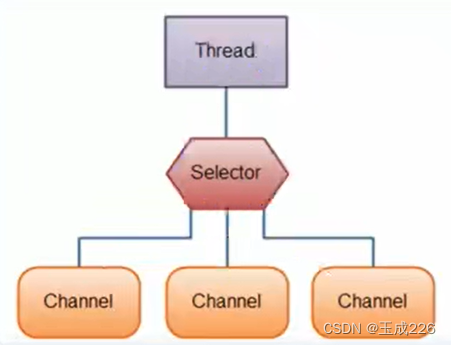
-
只有在连接真正有读写事件发生时,才会进行读写,就大大地减少了系统开销,并且不必为每个连接都创建一个线程,不用去维护多个线程。
-
避免了多线程之间的上下文切换导致的开销。
2、特点
- Netty的IO线程NioEventLoop聚合了Selector(选择器,也叫多路复用器),可以同时并发处理成百上千个客户端连接。
- 当线程从某客户端Socket通道进行读写数据时,若没有数据可用时,该线程可以进行其他任务。
- 线程通道将非阻塞IO的空闲时间用于在其他通道上执行IO操作,所以单独的线程可以管理多个输入和输出通道。
- 由于读写操作都是非阻塞的,这就可以充分提升IO线程的运行效率,避免由于频繁IO阻塞导致的线程挂起。
- 一个IO线程可以并发处理N个客户端连接和读写操作,这从根本上解决了传统同步阻塞IO一连接一线程模型,架构的性能、弹性伸缩能力和可靠性都得到了极大的提升。
3、Selector类相关方法
- Selector类是一个抽象类,常用的方法如下:
public abstract class Selector implements Closeable{
public static Selector open(); //得到一个选择器对象
public int select(); //阻塞
public int select(long timeout); //监控所有注册的通道,当其中有IO操作可以进行时,将对应的SelectionKey加入到内部集合中并返回,参数用来设置超时时间
public Set<SelectionKey> selectedKeys(); //从内部集合中得到所有的SelectionKey
}
- NIO非阻塞网络编程原理分析图
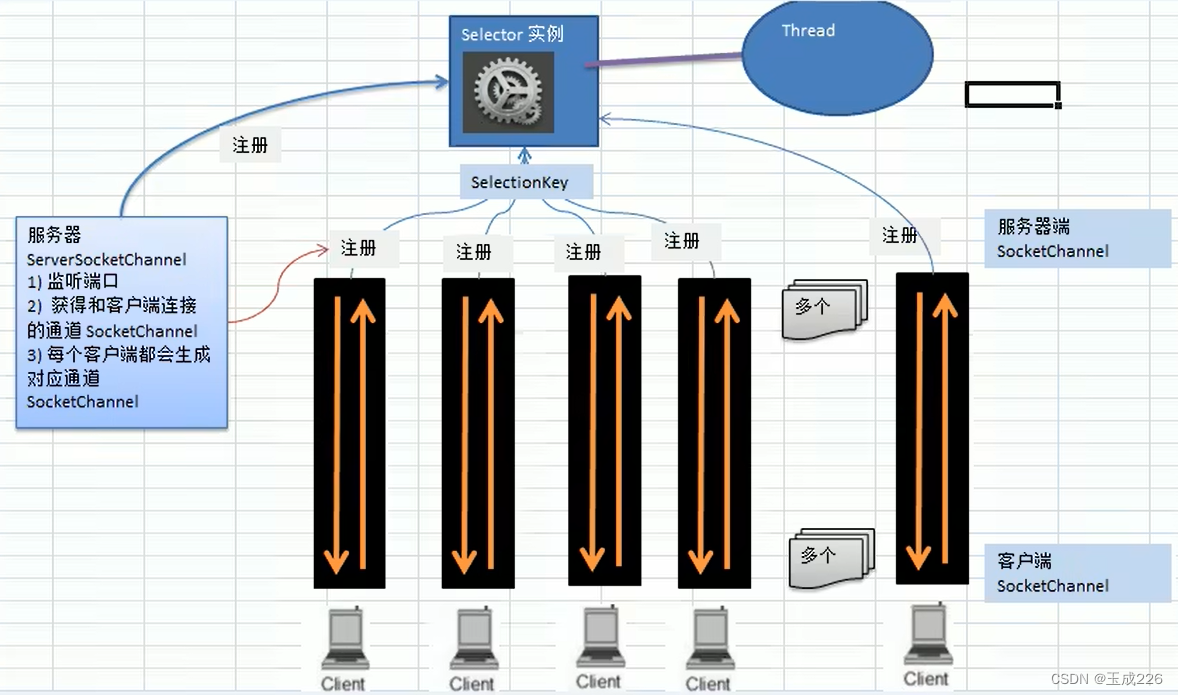
- 当客户端连接时,会通过ServerSocketChannel得到SocketChannel。
- 将SocketChannel注册到Selector上,register(Selector sel, int ops),一个selector上可以注册多个SocketChannel。
- 注册后返回一个SelectionKey,会和该Selector关联。
- Selector进行监听select方法,返回有事件发生的通道的个数。
- 进一步得到各个SelectionKey(有事件发生)。
- 在通过SelectionKey反向获取SocketChannel channel().
- 通过得到的channel完成业务处理。
4、常用API
(1)SelectionKey
SelectionKey,表示 Selector 和网络通道的注册关系,共四种:
- int OP_ACCEPT:有新的网络连接可以 accept,值为 16。
- int OP_CONNECT:代表连接已经建立,值为 8。
- int OP_READ:代表读操作,值为 1。
- int OP_WRITE:代表写操作,值为 4。
(2)ServerSocketChannel
ServerSocketChannel 在服务器端监听新的客户端 Socket 连接,负责监听,不负责实际的读写操作。
相关方法如下:
public static ServerSocketChannel open(); //得到一个ServerSocketChannel通道
public final ServerSocketChannel bind(SocketAddress local); //设置服务器端口号
public final SelectableChannel configureBlocking(boolean block); //设置阻塞或非阻塞模式,取值false表示采用非阻塞模式
public SocketChannel accept(); //接受一个连接,返回代表这个连接的通道对象
public final SelectionKey register(Selector sel, int ops); //注册一个选择器并设置监听事件
(3)SocketChannel
SocketChannel,网络 IO 通道,具体负责进行读写操作。NIO 把缓冲区的数据写入通道,或者把通道里的数据读到缓冲区。
相关方法如下:
public static SocketChannel open(); //得到一个SocketChannel通道
public final SelectableChannel configureBlocking(Boolean block); //设置阻塞或非阻塞模式,取值false表示采用非阻塞模式
public booleanconnect(SocketAddress remote); //连接服务器
public boolean finshConnect(); //如果上面的方法连接失败,接下来就要通过该方法完成连接操作。
public int wirte(ByteBuffer src); //往通道里写数据
public int read(ByteBuffer dts); //从通道里读数据
public final SelectionKey register(Selector sel, int ops, Object att); 注册一个选择器并设置监听事件,最后一个参数可以设置共享数据
public final void clise(); //关闭通道
5、实战
(1)实现服务端和客户端通信
编写一个 NIO 入门案例,实现服务器端和客户端之间的数据简单通讯(非阻塞)
- 服务端代码
package test.nio;
import java.io.IOException;
import java.net.InetSocketAddress;
import java.nio.ByteBuffer;
import java.nio.channels.*;
import java.util.Iterator;
import java.util.Set;
public class NIOServer {
public static void main(String[] args) throws IOException {
//创建ServerSocketChannel -> ServerSocket
ServerSocketChannel serverSocketChannel = ServerSocketChannel.open();
//得到一个selector对象
Selector selector = Selector.open();
//绑定一个端口6666,在服务器端监听
serverSocketChannel.socket().bind(new InetSocketAddress(6666));
//设置为非阻塞
serverSocketChannel.configureBlocking(Boolean.FALSE);
//把 serverSocketChannel注册到selector,关心事件为OP_ACCEPT
serverSocketChannel.register(selector, SelectionKey.OP_ACCEPT);
//循环等待客户端连接
while(Boolean.TRUE) {
//这里我们等待1秒,如果没有事件发生,返回
if (selector.select(1000) == 0) {
System.out.println("服务器等待了1秒,无连接");
continue;
}
//如果返回的>0,就获取到相关的selectorkey集合
//1.如果返回的>0,表示已经获取到关注的事件
//2.selector.selectedKeys()返回关注事件的集合
//3.通过selectionKeys反向获取通道
Set<SelectionKey> selectionKeys = selector.selectedKeys();
//遍历Set<SelectionKey>,使用迭代器遍历
Iterator<SelectionKey> iterator = selectionKeys.iterator();
while(iterator.hasNext()) {
//获取到SelectionKey
SelectionKey key = iterator.next();
//根据key对应的通道发生的事件做不同的处理
if (key.isAcceptable()) { //如果是OP_ACCEPT, 有新的客户端连接
//该客户端生成一个SocketChannel
SocketChannel socketChannel = serverSocketChannel.accept();
socketChannel.configureBlocking(Boolean.FALSE);
//将SocketChannel注册到selector, 关注事件为OP_READ,同时给socketChannel关联一个Buffer
socketChannel.register(selector, SelectionKey.OP_READ, ByteBuffer.allocate(1024));
}
if (key.isReadable()) { //发生了OP_READ事件
//通过key 反向获取到对应的channel
SocketChannel channel = (SocketChannel)key.channel();
//获取到读channel关联的Buffer
ByteBuffer buffer = (ByteBuffer)key.attachment();
channel.read(buffer);
System.out.println("from 客户端 " + new String(buffer.array()));
}
//手动从集合中移除当前的selectionKey,防止重复操作
iterator.remove();
}
}
}
}
-
对操作系统有一定了解的同学,就会大概知道这里监听的是一个Accept通道。这个通道的
作用就是监听,实际建立连接了还会有一个通道。 -
简单说一下为什么。因为客户端发请求的时候,服务器这边是肯定要先有一个监听通道,
监听某个端口是否有客户端要建立链接,如果有客户端想要建立链接,那么会再创建一个和
客户端真正通信的通道。 -
如果有其它客户端还想要建立链接,这个Accept监听端口监听到了,就会再创建几个真正
的通信通道。 -
也就是Server的一个端口可以建立多个TCP连接,因为IP层协议通过
目标地址+端口+源地址+源端口四个信息识别一个上下文。 -
客户端代码
package test.nio;
import java.io.IOException;
import java.net.InetSocketAddress;
import java.nio.ByteBuffer;
import java.nio.channels.SocketChannel;
public class NIOClient {
public static void main(String[] args) throws IOException {
//得到一个网络通道
SocketChannel socketChannel = SocketChannel.open();
//设置非阻塞
socketChannel.configureBlocking(Boolean.FALSE);
//提供服务器端的IP和端口
InetSocketAddress inetSocketAddress = new InetSocketAddress("127.0.0.1", 6666);
//连接服务器
if (!socketChannel.connect(inetSocketAddress)) {
while (!socketChannel.finishConnect()) {
System.out.println("因为连接需要时间,客户端不会阻塞,可以做其他的工作");
}
}
//如果连接成功,就发送数据
String str = "hello world";
ByteBuffer buffer = ByteBuffer.wrap(str.getBytes());
// 发送数据,将buffer数据写入channel
socketChannel.write(buffer);
System.in.read();
}
}
(2)群聊系统
实例要求:
- 编写一个 NIO 群聊系统,实现服务器端和客户端之间的数据简单通讯(非阻塞)。
- 实现多人群聊。
- 服务器端:可以监测用户上线,离线,并实现消息转发功能。
- 客户端:通过 Channel 可以无阻塞发送消息给其它所有用户,同时可以接受其它用户发送的消息(有服务器转发得到)。
六、Selector、Channel和Buffer关系
- 每个channel都会对应一个Buffer。
- Selector对应一个线程,一个线程对应多个channel(连接)。
- 程序切换到那个Channel是由事件决定的,Event就是一个总要的概念。
- Selector会根据不同的事件,在各个通道上切换。
- Buffer就是一个内存块,底层是一个数组。
- 数据的读取写入是通过Buffer。BIO中要么是输入流要么是输出流,不能双向。但是NIO的Buffer是可以读也可以写的,需要调用flip方法切换。
- channel是双向的,可以返回底层操作系统的情况,比如Linux,底层的操作系统通道就是双向的。
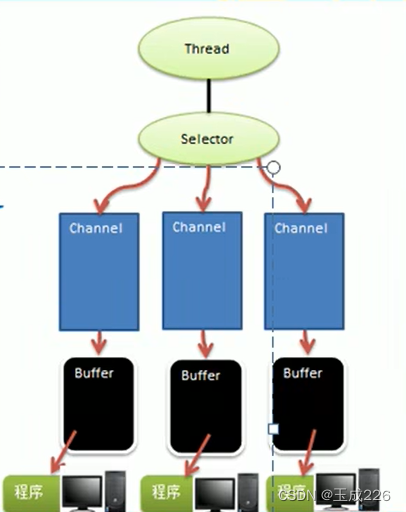
package test.nio;
import java.nio.IntBuffer;
public class BasicBuffer {
public static void main(String[] args) {
//创建一个buffer, 容量大小为5,即可以存放5个int
IntBuffer buffer = IntBuffer.allocate(5);
for (int j = 0; j < 5; j ++) {
//向buffer中存放数据
for (int i = 0; i < buffer.capacity(); i++) {
buffer.put(i * 2);
}
//从buffer中读取数据
buffer.flip();
while(buffer.hasRemaining()) {
int i = buffer.get();
System.out.println(i);
}
System.out.println("==============================================================================");
buffer.flip();
}
}
}
输出结果:
0
2
4
6
8
==============================================================================
0
2
4
6
8
==============================================================================
0
2
4
6
8
==============================================================================
0
2
4
6
8
==============================================================================
0
2
4
6
8
==============================================================================
Process finished with exit code 0





 本文详细介绍了Java NIO的核心内容,包括NIO的原理,其三大核心部分通道、缓冲区和选择器的作用及工作机制。阐述了Buffer的原理、实现类和使用方法,对比了NIO与BIO。还介绍了Channel和Selector的相关知识,并给出服务端与客户端通信、群聊系统的实战案例。
本文详细介绍了Java NIO的核心内容,包括NIO的原理,其三大核心部分通道、缓冲区和选择器的作用及工作机制。阐述了Buffer的原理、实现类和使用方法,对比了NIO与BIO。还介绍了Channel和Selector的相关知识,并给出服务端与客户端通信、群聊系统的实战案例。

















 325
325

 被折叠的 条评论
为什么被折叠?
被折叠的 条评论
为什么被折叠?










